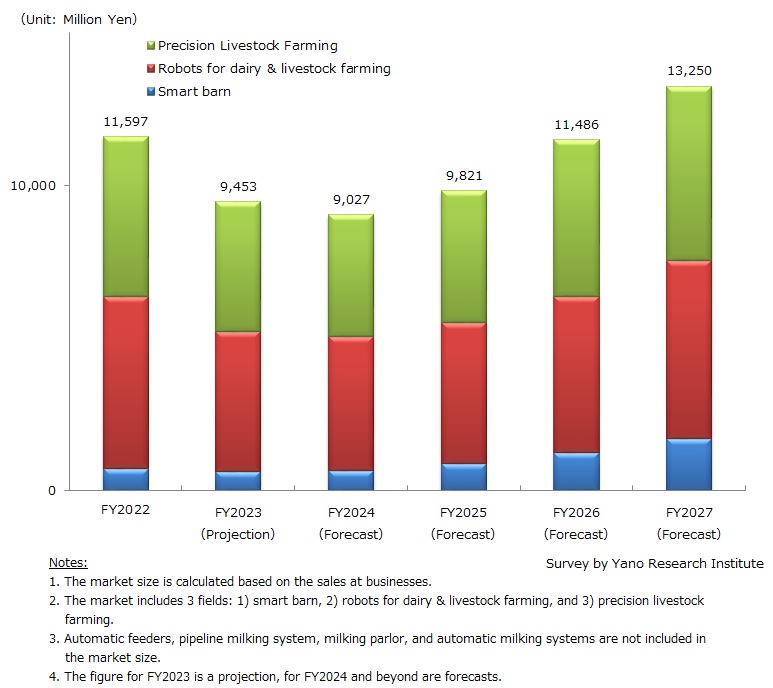No.3308
Smart Dairy & Livestock Farming in Japan: Key Research Findings 2023
Domestic Smart Dairy & Livestock Farming Market Estimated at 11,597 Million Yen for FY2022
Yano Research Institute (the President, Takashi Mizukoshi) has conducted a survey on the domestic market of smart dairy & livestock farming, and found out the market size, the trends by market players, and future perspectives.

Market Overview
Smart dairy & livestock farming market size in Japan for FY2022 is estimated at 11,597 million yen, based on the sales at businesses.Smart dairy & livestock farming in this research aims to achieve more productive and efficient farm operations based on the use of information and communication technologies (ICT) with traditional production techniques. The smart dairy & livestock farming contributes to the improvement of whole dairy & livestock farming supply chain by increasing productivity, reducing cost, ensuring food safety, and improving workplace safety.As the number of dairy & livestock farm declines rapidly due to a lack of successors and aging of farmers, a need to implement smart dairy & livestock farming increases to save labor and improve precision. Digitization of management skills, knowledge, and experience is necessary to transfer the knowledge assets to successors. Coupled with the soaring feed prices that blow up the production cost, there is an urgent need to improve efficiency for cost reduction.Under the circumstances, in conjunction with the subsidy by the Ministry of Agriculture, Forestry and Fisheries (MAFF), the strong sales of robots and smart barns drove the market growth.
Noteworthy Topics
Penetration of Smart Barns & Precision Livestock Farming for Improving Animal Welfare Awaited
While a concern over the welfare of farm animals grew primarily in the Western countries, it is also gaining domestic recognition gradually. In June 2021, the European Commission announced its intention to put forward a legislative proposal by the end of 2023 to commit to phase out cages in animal farming across the EU member countries by 2027. Calls for animal welfare for farmed animals, led mainly by the EU, could become a global trend hereafter.
Improving animal welfare may as well promises both greater productivity and safer animal products for domestic dairy and livestock farmers, since securing a comfortable environment for farm animals reduce their susceptibility to stress and risk of diseases. Under the circumstances, research and development on smart barns and precision livestock farming technologies using AI in consideration of animal welfare is underway to support efficient animal husbandry.
Future Outlook
The domestic market of smart dairy & livestock farming is forecasted to reach 9,453 million yen for FY2023 and 9,027 million yen for FY2024, based on the sales at businesses. A main reason for the decline is the downward trend in farmer’s facility investments. In addition to the exclusion of new barn construction and robot introductions from the MAFF’s subsidy fostering the development of smart dairy & livestock farming, soaring feed prices and energy costs, such as electricity bills, have discouraged farmers (dairy & livestock farmers) to invest.
Meanwhile, dairy and livestock farmers are facing various challenges to address, such as labor shortages, emission of greenhouse gas derived from dairy and livestock farming, and animal welfare. Smart dairy and livestock farming is essential as a solution to these issues. Under the circumstances, the market is expected to turn for the better again from FY2025 onward, and expand to 13,250 million yen for FY2027, 114.3% of the FY2022 level.
Research Outline
2.Research Object: Businesses in smart dairy & livestock farming, agricultural corporations (cattle farmer, pig farmer, chicken farmer), related industry bodies/associations, competent authorities, etc.
3.Research Methogology: Face-to-face interviews by our expert researchers, survey via telephone/email, and literature research
What is the Smart Dairy & Livestock Farming?
Smart dairy & livestock farming in this research aims to achieve more productive and efficient farm operations based on the use of information and communication technologies (ICT) with traditional production techniques. The smart dairy & livestock farming contributes to the improvement of whole dairy & livestock farming supply chain by increasing productivity, reducing cost, ensuring food safety, and improving workplace safety. The market includes the following 3 fields: 1) smart barns, 2) robots for dairy & livestock farming, and 3) precision livestock farming (PLF). Size of the market reflects domestic market only and is calculated based on the sales at businesses. However, automatic feeders, pipeline milking system, milking parlor, and automatic milking systems are excluded.
The 3 fields are defined as follows:
(1) Smart barn is the barn (cattle shed, pigsty) using highly intelligent control system to optimize environments for raising farm animals, which includes IoT based systems that relates to barn management (feed tank level monitoring systems, etc.).
(2) Robots for dairy & livestock farming can automate tasks such as milking, nursing (automatic milk-feeding system for piglets, etc.,), feeding (self-guided feed pusher which may also weigh & mix feed, etc.,), and barn cleaning.
(3) Precision livestock farming (PLF) refers to the suite of sensing and monitoring technologies to record data of animals (breeding status, nutritional condition, health condition, etc.) and technologies to utilize collected data (reproduction monitoring [estrus and calving], disease detection, imaging solution to estimate body weight, etc.).
Published Report
Contact Us
The copyright and all other rights pertaining to this report belong to Yano Research Institute.
Please contact our PR team when quoting the report contents for the purpose other than media coverage.
Depending on the purpose of using our report, we may ask you to present your sentences for confirmation beforehand.